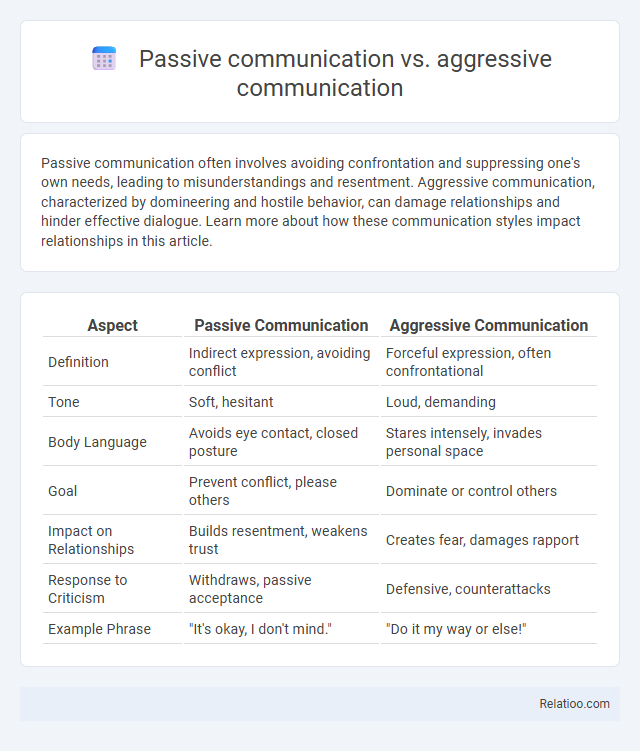Passive communication often involves avoiding confrontation and suppressing one's own needs, leading to misunderstandings and resentment. Aggressive communication, characterized by domineering and hostile behavior, can damage relationships and hinder effective dialogue. Learn more about how these communication styles impact relationships in this article.
Table of Comparison
| Aspect | Passive Communication | Aggressive Communication |
|---|---|---|
| Definition | Indirect expression, avoiding conflict | Forceful expression, often confrontational |
| Tone | Soft, hesitant | Loud, demanding |
| Body Language | Avoids eye contact, closed posture | Stares intensely, invades personal space |
| Goal | Prevent conflict, please others | Dominate or control others |
| Impact on Relationships | Builds resentment, weakens trust | Creates fear, damages rapport |
| Response to Criticism | Withdraws, passive acceptance | Defensive, counterattacks |
| Example Phrase | "It's okay, I don't mind." | "Do it my way or else!" |
Understanding Passive Communication
Passive communication involves avoiding expressing one's thoughts, feelings, and needs, often leading to misunderstandings and unmet expectations. Unlike aggressive communication, which is confrontational and forceful, passive communication prioritizes conflict avoidance but may result in suppressed emotions and reduced self-esteem. Recognizing passive communication patterns is essential for developing assertiveness skills and improving interpersonal relationships.
Defining Aggressive Communication
Aggressive communication involves expressing thoughts and feelings in a forceful, demanding, or hostile manner that often violates others' rights and creates conflict. This style contrasts with passive communication, which avoids expressing personal needs, and assertive communication, which balances respect for both self and others. Understanding aggressive communication helps you recognize behaviors that can damage relationships and hinder effective dialogue.
Key Traits of Passive Communicators
Passive communicators often avoid expressing their opinions or feelings, leading to a lack of assertiveness and difficulty in setting boundaries. They tend to prioritize others' needs over their own, which can result in feelings of resentment and low self-esteem. Understanding these key traits helps you recognize when passive communication negatively impacts your interactions and encourages the development of healthier communication skills.
Common Behaviors in Aggressive Communication
Aggressive communication often involves behaviors such as yelling, interrupting, and blaming others, reflecting a domineering and confrontational approach. Individuals displaying aggressive communication tend to disregard others' feelings and rights, using intimidation or threats to assert control. This contrasts with passive communication, where individuals avoid expressing their own needs, and passive-aggressive communication, characterized by indirect resistance and hidden hostility.
Psychological Impact of Passive Communication
Passive communication often leads to unexpressed emotions and internalized stress, causing increased anxiety and decreased self-esteem. Your inability to assert needs can create feelings of helplessness and depression, affecting mental health negatively. In contrast, aggressive communication tends to provoke conflict, while passive-aggressive behavior combines avoidance with indirect hostility, both resulting in strained relationships.
Consequences of Aggressive Communication
Aggressive communication often leads to damaged relationships, increased conflict, and diminished trust due to its confrontational and hostile nature. Unlike passive communication, which may cause misunderstandings by withholding true feelings, aggressive communication alienates others and provokes defensiveness. You risk creating a toxic environment where collaboration and mutual respect are significantly hindered when aggressive communication dominates interactions.
Comparative Analysis: Passive vs Aggressive Styles
Passive communication tends to avoid confrontation and often leads to misunderstandings, while aggressive communication prioritizes dominating conversations and disregards others' feelings, creating conflict. Your effectiveness in conveying messages improves significantly when you recognize that passive communication may result in unmet needs, whereas aggressive communication can damage relationships and hinder collaboration. Balancing assertiveness between these extremes enables clearer expression and fosters mutual respect in communication.
Real-Life Scenarios: Passive and Aggressive Responses
In real-life scenarios, passive communication often leads to unmet needs and frustration as individuals avoid expressing their opinions or desires, resulting in misunderstandings and stress. Aggressive communication, characterized by dominating or hostile behavior, typically causes conflict and damages relationships due to a lack of respect for others' perspectives. Passive-aggressive communication combines avoidance with indirect hostility, creating confusion and eroding trust by masking true feelings behind sarcasm or subtle resistance.
Overcoming Passive and Aggressive Communication Patterns
Overcoming passive and aggressive communication patterns involves developing assertive communication skills that balance respect for oneself and others. Techniques such as clear expression of needs, setting boundaries, and practicing active listening help transform passive tendencies into confident dialogue and redirect aggressive impulses into constructive conversations. Consistent self-awareness and emotional regulation are essential for maintaining effective, assertive communication that fosters mutual understanding and collaboration.
Building Healthier Communication Strategies
Building healthier communication strategies involves recognizing the differences between passive, aggressive, and assertive communication styles. Passive communication often leads to unmet needs and resentment due to lack of self-expression, while aggressive communication can cause conflict and damage relationships through hostility. Assertive communication balances expressing personal needs with respect for others, fostering mutual understanding and promoting positive interpersonal connections.

Infographic: Passive communication vs Aggressive communication
 relatioo.com
relatioo.com